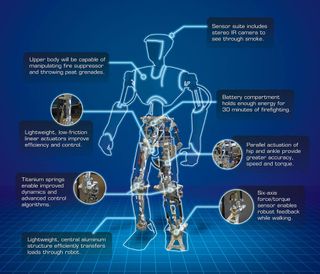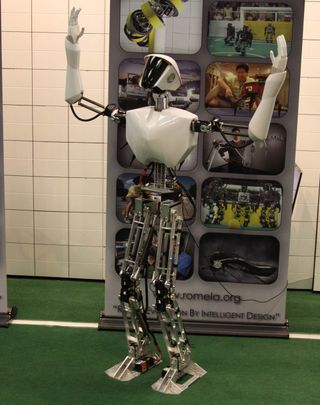Navy's Robot Firefighter to Throw Extinguisher Grenades

Fire has proven deadly for sailors throughout the centuries of naval warfare. The U.S. Navy wants to counter that ancient foe with a humanoid robot capable of throwing extinguisher grenades as it nimbly moves about the narrow passages and ladderways of modern warships.
A robot firefighter capable of walking or climbing in the manner of human sailors would present a huge advantage over one of today's military robots — which rely upon wheels or tanklike treads — in operating in the cramped quarters of warships. But the U.S. military also has set its sights on "other potential warfighting applications" in choosing to create a humanoid robot, according to the Naval Research Laboratory.
The Shipboard Autonomous Firefighting Robot (SAFFiR), which is still 18 months away from being tested, would not only battle flames on its own, but work together with sailors. It would follow the gaze of a human leader, respond to hand signals and even obey voice commands.
SAFFiR would need finger and hand coordination to wrestle fire hoses into place or accurately throw extinguisher grenades. It similarly would need the sure-footed balance of a veteran sailor's sea legs to confidently walk the wave-tossed decks of warships.

An infrared camera could allow such a robot to see through smoke-filled hallways, and perhaps it could detect the location of fires through gas sensors. The robot's battery is intended to pack enough energy for half an hour of firefighting action.
The Navy's planned robot builds upon the design of a humanoid CHARLI-L1 robot already created by Virginia Tech. Researchers from Virginia Tech and the University of Pennsylvania continue to work with the Naval Research Laboratory on its more ambitious goals.
A first test for the firefighting robot is scheduled to take place aboard a decommissioned Navy dock landing ship, the Shadwell, in late September 2013. The ex-USS Shadwell, now used for firefighter training, is no stranger to the dangers of naval warfare: Its crew shot down a Japanese Zero fighter plane, and it suffered a torpedo hit while carrying Marine assault craft during World War II.
Sign up for the Live Science daily newsletter now
Get the world’s most fascinating discoveries delivered straight to your inbox.
For now, SAFFiR remains a firefighting robot meant to save human lives. But a military robot designed to follow commands, point fire hoses at targets and toss grenades could very well evolve down the road into a "Terminator" soldier.
Follow InnovationNewsDaily on Twitter @News_Innovation, or on Facebook.

